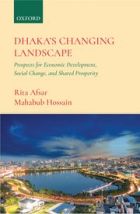Dhaka’s Changing Landscape: Prospects for Economic Development, Social Change, and Shared Prosperity

Dhaka’s growth over the past 70-odd years has been astonishing. At the time of India’s Partition in 1947, this city in East Pakistan numbered no more than 300,000. On independence in 1971, it had grown to 1.5 million. By the new millennium, the megacity had 16.3 million inhabitants. The population now exceeds 20 million.
This growth in population has been accompanied by dramatic economic growth, with the city accounting for over 36 per cent of the national economy by 2013. Of course, the rising economic tides have not lifted everyone equally, and environmental challenges have mounted. Thus, Dhaka’s Changing Landscape sets out to answer three questions: “first, is the poorer segment of urban population that migrates with dreams for better lives and livelihoods benefitting from positive economic trends? Second, are these benefits sustainable in the long run? Third, have these benefits brought qualitative changes creating scope for this group to have a stake in the country’s growing prosperity like their non-poor counterparts?” (page 9)
The book draws on three rounds of surveys – from 1991, 1998 and 2010 – conducted in four wards of Dhaka, which included both slum and non-slum households. The changing research strategy itself illustrates the sweeping changes in Dhaka over the research period. For instance, in 1991, authors Rita Afsar and Mahabub Hossain were able to identify slums by their temporary structures, including mainly bamboo roofs. But by 2010, concrete blanketed both slum and non-slum neighbourhoods. Rather than checking the type of material used to construct houses, Afsar and Hossain assessed the availability of basic amenities – such of gas, water and toilets – to identify slum households.
Employment has also shown major changes over the decades. The home villages of migrants to Dhaka are now better off and more connected to towns. As rural livelihoods have diversified from agriculture, the occupations of Dhaka’s poorer migrants have shifted as well; the transport and construction sectors are now the primary sectors. The authors’ survey data from hundreds of households allow them to track shifts in a number of factors, including upward mobility and reliance on social contacts for financial support.
While shining a light on the Dhaka of 2010, Dhaka’s Changing Landscape also suggests that the city is transforming rapidly enough that present-day Dhaka may already look substantially different.
Further reading:
Banks, Nicola (2015), “Female employment in Dhaka, Bangladesh: participation, perceptions and pressures”, Environment and Urbanization Vol 25, No 1, pages 95–109, available at https://journals.sagepub.com/doi/full/10.1177/0956247813477357.
Begum, Sharifa and Binayak Sen (2005), “Pulling rickshaws in the city of Dhaka: a way out of poverty?”, Environment and Urbanization Vol 17, No 2, pages 11–25, available at https://journals.sagepub.com/doi/pdf/10.1177/095624780501700202.
Taylor, John (2020), “How Dhaka’s urban poor are dealing with COVID-19”, 1 July, Urban Matters, International Institute for Environment and Development, available at https://www.iied.org/how-dhakas-urban-poor-are-dealing-covid-19.
Search the Book notes database
Our Book notes database contains details and summaries of all the publications included in Book notes since 1993 - with details on how to obtain/download.
Use the search form above, or visit the Book notes landing page for more options and latest content.
For a searchable database for papers in Environment and Urbanization, go to http://eau.sagepub.com/

